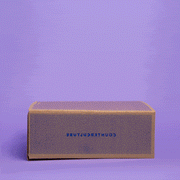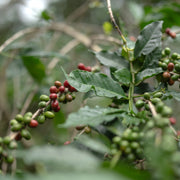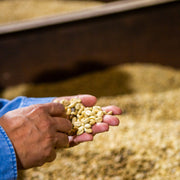Espresso–is it a bean, a brew method, or a beverage? Yes! It turns out that the answer is a little bit of all three.
Is Espresso A Kind Of Bean?
The number one question we get when asked for coffee recommendations is “which of your coffees is best for espresso?” Or, “Which coffee is your espresso roast?” When we solidified our lineup of seven year-round offerings, we made a deliberate choice to not designate any of them as being specifically “espresso” roasts or blends. Instead, we adopted our philosophy of any coffee, any brew.
This philosophy is about flexibility and versatility while also understanding that flavor preferences are formed by history and personal experience. Like everything else in coffee, what you look for in espresso may be totally unappealing to someone else. Let’s have a quick look at the history of espresso and see if we can figure out why we like what we like, and what’s best.

History Of Espresso
Espresso machines were invented in Italy in the early 20th century to speed the making of the viscous, Arabic-style coffee popular at the time. The industrial revolution was in full swing and factory workers in Italy needed their coffee fix during their short breaks. Wouldn’t you know it – espresso took off!
At the time, the coffees that Italian roasters used were quite chocolaty and nutty and the favored roasting style was also pretty dark. The result was an espresso that tended to be sweet like chocolate, with a heavy, smoky body. It makes sense then that those are the characteristics we now associate with “espresso flavor.” Nowadays, when roasters write espresso on the side of a bag, they’re communicating all of this history and priming your expectations. But does that mean this is the only type of coffee we can use to make espresso?
In modern cafes, espresso flavor takes many forms. Some are more traditional, and some are lighter, brighter, and fruitier. Which one of our coffees is best for espresso? Just ask yourself, “what do I like?” If you enjoy coffee that tastes like hot chocolate, go for Big Trouble. If you prefer something a little fruity and bright, try Apollo or any of our single-origin offerings. You brew you!
Is Espresso A Brew Method?

The simplest definition of espresso is that it’s a concentrated coffee beverage made by forcing hot water through finely-ground coffee. To do this well, you need very specific equipment, including an espresso machine and an espresso grinder. The machine is designed to make water hot and push it through the coffee with force. That’s the only way to create the characteristic foamy crema on top of the beverage.
Because the water is being pushed through the coffee, you need a very fine grind to offer up some resistance and get an appropriate brew time. Standard grinders, used to make filter coffee, are generally not capable of producing a grind fine enough to get this resistance. That’s why a large part of what defines espresso is the equipment and its appropriate use.
Our Go-To Espresso Recipe
Espresso recipes come in all shapes and sizes. But if you have a new coffee you need to dial in, you need to know where to start! The following recipe is a great baseline to work from, and should give you nice results with most coffees.
Dose: 18 grams
Yield: 36 grams of liquid in cup
Time: 28 seconds

Is Espresso A Beverage?
Navigating the espresso menu can be tricky. What are you going to get when you order an espresso, cappuccino, or latte? Let’s decode that a little.
First, when you order an espresso in a modern specialty coffee shop, you’re usually getting a double espresso. And that double is the foundation of most espresso drinks these days. A double espresso is defined by the amount of coffee and the amount of water the barista uses to make it. If you order a single espresso, the barista will still follow the same recipe (coffee, water, timing), but use the spouts on the bottom of the portafilter to split the recipe in half.
In addition to espresso, what are the other drinks on cafe menus? Just about every other drink is a double espresso plus some amount of milk. What’s the difference between a cappuccino and a latte? In most places, a cappuccino has less milk than a latte. Beyond that, the difference is determined by the guidelines of the specific cafe. Is there too much foam or not enough on the drink you ordered? Just speak to your barista. They’re usually able to accommodate your preferences!
Espresso: ~2 ounces espresso
Cortado: ~2 ounces espresso + 3 ounces steamed milk
Cappuccino: ~2 ounces espresso + 6 ounces steamed milk
Flat White: ~2 ounces espresso + 6 ounces steamed milk (less foam than cappuccino)
Latte: ~2 ounces espresso + 10 ounces steamed milk
Americano: ~2 ounces espresso + 8 ounces hot water

Caffeine In Espresso
A common question here is about caffeine: Is there more caffeine in a double espresso than a cup of coffee? Measuring by volume, yes. For example, a 10 oz. espresso will certainly give you a bigger buzz than a 10 oz. cup of drip coffee! Yet, most of us are drinking either 10 oz. of coffee or ~2 oz. of espresso. In that case, they’re roughly the same, with the coffee usually having slightly more caffeine.
Why the bigger buzz from espresso? It’s hard to explain without diving into some pretty heavy physiology, but, in general, just think about how people consume it. We drink espresso fast and filter coffee a little slower. You’re going to get a bigger caffeine hit from the espresso largely because you’re drinking it faster!
So what is espresso? It’s a little bit of everything. It’s a brew method, a bean, and a beverage. The more you experience and taste different versions of espresso, the more you’ll learn about it and your own preferences. And in the end, isn’t that what’s most important?







